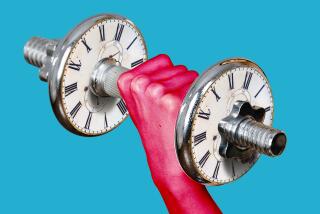Good Bones Come From Calcium, Exercise
- Share via
When my friend broke her leg, I worried that she might be laid up a long time. After all, nearly 30 million Americans have lost enough bone density because of osteoporosis to be at great risk of suffering fractures--and the way most middle-aged or elderly women discover that they have the disease is by breaking a bone. Indeed, the National Osteoporosis Foundation says, the disease is responsible for more than 1.5 million fractures annually, of which 300,000 are hip fractures. Worse, half of all hip-fracture patients never leave the hospital, while 20% of them die within a year. That accounts for more deaths than breast cancer, uterine cancer and ovarian cancer combined. No wonder osteoporosis is sometimes called “the silent killer.”
*
So, what can we do to prevent, halt or reverse osteoporosis?
If you’re 30 or younger--the critical years for building bone mass--get plenty of calcium in your diet. The stronger your bones are early, the more bone loss you can afford later on. Dietary calcium is so important that teenage girls with eating disorders, or very poor diets, often have the brittle bones of an elderly woman.
Of course, calcium is important at any age. The best sources are dietary, through dairy products, tofu, fortified orange juice and collard greens, but you can also take supplements that bring your total daily intake to at least 1,000 milligrams. And to aid calcium absorption, be sure to get enough vitamin D (from 200 IUs a day for young people, to 800 a day for post-menopausal women), the best sources of which are sunlight and fortified milk.
Then exercise, exercise, exercise. Weight-bearing exercises like brisk walking, jogging, dancing, hiking, etc., are better than swimming and cycling because your bones are forced to support your weight; it’s the pounding that makes them stronger. Studies have shown that astronauts who return from as few as three days of weightless space experience measurable bone loss, whereas even the very elderly who begin exercise programs can enjoy increases in bone density.
And because there is a direct correlation between the amount of muscle in a body and bone density, post-menopausal women who begin weightlifting and other strength-training exercises can actually increase bone strength in the hips and spine--the two major areas that suffer the most crippling effects of osteoporosis. That’s great news!
*
Another benefit of strength training and aerobic exercises is a marked improvement in balance. Better balance translates to a lessened risk of falling, which, of course, translates to fewer broken bones.
Knowing all of this, I shouldn’t have been so worried about my friend after she broke her leg. As a girl she was very athletic; moreover, she exercises at least five days a week and eats a generally healthy diet. The net result, according to her elated physician, was a bone that would heal quickly.
I’d like to think that the rest of us can also experience such positive prognoses. Let’s defeat this silent killer, one woman at a time.
*
Copyright 1999 by Kathy Smith
Kathy Smith’s fitness column appears weekly in Health. Reader questions are welcome and can be sent to Kathy Smith, Health, Los Angeles Times, Times Mirror Square, Los Angeles, CA 90053. If your question is selected, you will receive a free copy of her book “Getting Better All the Time.” Please include your name, address and a daytime phone number with your question.




